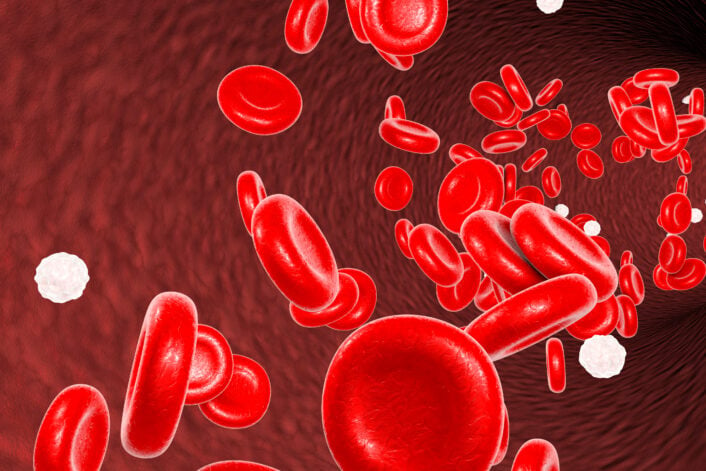

Disclaimer: This article is for informational purposes only and is not intended for diagnostic use. LifeDNA does not provide diagnostic reports on any traits discussed. Genetics is just one piece of the puzzle; please consult a healthcare professional for comprehensive guidance on any health condition.
Blood clots can be a silent threat, forming in your body without warning and leading to serious health complications like deep vein thrombosis or even a stroke. But have you ever wondered why some people are more prone to clots than others? The answer might lie in your genes.
Thrombophilia, a condition where the blood has an increased tendency to clot, can be inherited, meaning your risk could be passed down through generations. This article explores the genetic roots of thrombophilia, shedding light on how your family history could influence your body’s clotting tendencies.
Blood clots form when the body’s natural clotting process, meant to stop bleeding from an injury, goes awry. Normally, when a blood vessel is damaged, the body sends platelets to the site to form a plug, and specific proteins in the blood called clotting factors work together to solidify the clot. This is a vital function to prevent excessive bleeding.
However, clots can also form inappropriately inside blood vessels. These can be caused by factors like prolonged immobility, damage to blood vessels from surgery or trauma, or underlying medical conditions. Some individuals have a genetic predisposition to developing clots more easily, a condition known as thrombophilia.
Genetics can influence a person’s overall risk, but lifestyle factors such as smoking, obesity, and inactivity can also elevate the chances of abnormal clot formation. Understanding how both genetic and environmental factors contribute to blood clot formation helps individuals manage their risk and make informed lifestyle decisions to protect their health.
Blood clots can be dangerous, especially when they form in places where they aren’t needed. A clot that develops inside a blood vessel without injury can block blood flow, leading to serious health issues.
If a clot forms in a vein deep within the body, it is called deep vein thrombosis (DVT). DVT most commonly occurs in the legs and can cause swelling, pain, and redness. If part of the clot breaks off and travels to the lungs, it can result in a pulmonary embolism (PE), a life-threatening condition that blocks blood flow to the lungs.
Blood clots can also form in arteries, where they can cut off oxygen to vital organs. For example, a clot in the arteries leading to the brain can cause a stroke, while one in the coronary arteries can trigger a heart attack.
Thrombophilia is a medical condition where the blood has an increased tendency to form clots. Normally, the body creates clots to stop bleeding after an injury, but in people with thrombophilia, clots can develop even when they aren’t needed.
Thrombophilia can be inherited or acquired. Inherited thrombophilia occurs when a person carries specific genetic mutations that make their blood more prone to clotting. Factor V Leiden mutation is the most common cause along with Prothrombin G20210A Mutation. People with particular mutations have a higher risk of developing abnormal blood clots, particularly under certain conditions such as surgery, pregnancy, or long periods of immobility.
Acquired thrombophilia, on the other hand, develops due to external factors like prolonged bed rest, cancer, or autoimmune diseases such as antiphospholipid syndrome. While it’s not passed down through families, it shares the same dangerous potential for clot formation.
For individuals with inherited thrombophilia, genetics play a key role in their clotting tendencies. However, lifestyle factors such as diet, exercise, smoking, and even certain medications can impact their overall risk. A person’s habits and health choices can either reduce or increase the likelihood of a clot forming. This makes understanding their genetic predisposition crucial for managing their health.
By combining knowledge of genetics with smart lifestyle modifications, those with thrombophilia can take steps to reduce the risk of dangerous clot formation. Regular medical check-ups, maintaining a healthy weight, and staying active are just a few ways to manage the condition effectively. Recognizing the role genetics plays helps individuals make informed decisions about their health.
Thrombophilia, particularly the inherited form, cannot be cured because it is rooted in a person’s genetic makeup. Since these genetic mutations are part of a person’s DNA, they cannot be altered or reversed. However, while the condition cannot be cured, it can be effectively managed to reduce the risk of dangerous blood clots.
Management strategies typically involve preventing clot formation, especially during high-risk situations. For individuals with thrombophilia, this may include using anticoagulant medications (blood thinners) like warfarin or heparin, especially before surgery, during pregnancy, or when a person is immobilized for long periods. These medications reduce the blood’s ability to clot, lowering the chance of clot-related complications like DVT or PE.
Lifestyle changes are also important. Regular physical activity, staying hydrated, avoiding prolonged periods of immobility, and maintaining a healthy weight can help lower the risk of clots.
In the case of acquired thrombophilia, such as antiphospholipid syndrome, the condition is related to other health factors such as autoimmune diseases. While it may not be curable, managing the underlying condition can reduce clotting risks.
Although a complete cure for thrombophilia does not exist, understanding how genetics influence clotting tendencies allows individuals to take proactive steps. With proper management, they can live normal, healthy lives while minimizing the potential complications of this condition.
Several conditions can cause thrombophilia, increasing the risk of abnormal blood clot formation. These conditions either affect the blood’s clotting factors or create an environment in the body that promotes clotting. Here are some key conditions that can cause primary or secondary thrombophilia:
Understanding these conditions and their genetic components helps individuals manage their thrombophilia risk and make informed lifestyle choices to reduce complications.
Thrombophilia can be life-threatening, especially if it leads to dangerous blood clots in critical areas of the body. Here’s how it can become serious:
While thrombophilia itself may not always cause immediate problems, the clots it triggers can lead to life-threatening conditions. Understanding the genetic risks and managing lifestyle factors can significantly reduce these dangers.
Thrombophilia itself does not always cause symptoms, but it increases the likelihood of blood clots, which can present with various symptoms depending on where they form. Here are the most common signs of thrombophilia-related complications:
DVT is common in the legs but can occur also in other deep veins. If untreated, it can lead to a life-threatening pulmonary embolism.
A PE occurs when a blood clot from another part of the body, like a leg, travels to the lungs, blocking blood flow and oxygen.
Thrombophilia increases the risk of clotting in the arteries that lead to the brain, which can cause a stroke.
Recognizing these symptoms and understanding the role of genetics in thrombophilia helps individuals seek timely medical intervention and make informed lifestyle choices to reduce clotting risks.
Thrombophilia treatment focuses on preventing abnormal blood clots from forming and management of existing clots. While thrombophilia itself cannot be cured, treatments can significantly reduce the risk of dangerous complications. The treatment approach varies depending on the type of thrombophilia, the individual’s personal and family history, and any other underlying risk factors.
Anticoagulants are the primary treatment for thrombophilia. These medications reduce the blood’s ability to clot, helping to prevent new clots from forming and stopping existing ones from growing. Common anticoagulants include:
When to Use: Anticoagulants are often prescribed after a clot has already formed or in high-risk situations such as surgery, prolonged immobility, or pregnancy. Individuals with genetic thrombophilia, such as Factor V Leiden or prothrombin mutation, may be placed on long-term anticoagulation therapy depending on their clotting history.
For those with a history of deep vein thrombosis (DVT), compression stockings can help improve blood circulation and reduce swelling in the legs. These stockings apply pressure to the legs, preventing blood from pooling and lowering the risk of new clots forming.
Lifestyle changes play a crucial role in reducing thrombophilia-related clotting risks. These modifications can be especially important for individuals with inherited thrombophilia, as they can help counterbalance genetic predispositions:
For individuals with acquired thrombophilia, such as antiphospholipid syndrome (APS), treating the underlying condition is essential. APS is an autoimmune disorder that causes excessive clotting, and managing the immune system through medications like corticosteroids or immunosuppressants can help reduce clotting risk.
Pregnant women with thrombophilia require special care because of the increased risk of clots during pregnancy. Anticoagulation therapy, typically with low molecular weight heparin (LMWH), is often used to prevent clots, especially in women with a history of recurrent miscarriages due to thrombophilia. Regular monitoring and careful management of clotting factors during pregnancy can ensure a safer outcome for both the mother and baby.
For individuals on long-term anticoagulation therapy, regular blood tests are critical to monitor clotting levels and adjust medication as needed. This is especially true for those taking warfarin, which requires close monitoring of the International Normalized Ratio (INR) to ensure the blood is not too thin or too thick.
Although thrombophilia cannot be cured, a combination of anticoagulant therapy, lifestyle changes, and careful medical management can help individuals significantly reduce the risk of dangerous blood clots. Understanding the role that genetics and environmental factors play in the condition allows for a personalized approach to treatment, helping individuals lead healthier lives while minimizing the risk of serious complications.


